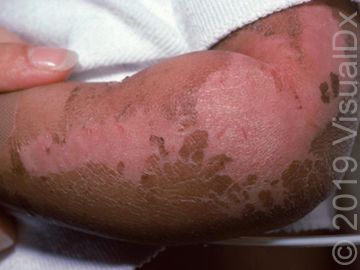Article
Image IQ: Baby girl with peeling skin and diarrhea
The parents of a 7-month-old girl brought their daughter to the ED after noticing that her skin was peeling all over her body. She also had diarrhea. What's your diagnosis?
Image courtesy of VisualDx.

The parents of a 7-month-old girl brought their daughter to the ED after noticing that her skin was peeling all over her body. She also had diarrhea. They noticed that she seemed much more irritable than usual and was drooling a lot. The ED doctors asked about the infant’s recent health, and the parents explained that she had been suffering from severe atopic dermatitis. The pediatrician had prescribed antibiotics and topical steroids, but they suspected a food allergy since her parents had been feeding her a restrictive diet of rice milk. Lab tests showed the baby was anemic.
What's your diagnosis?
A. Pellagra
B. Kwashiorkor
C. Riboflavin deficiency
D. Kawasaki disease
Use the differential builder in VisualDx to help select a diagnosis.
See the next page for the answer.
The correct answer is D) Kwashiorkor.
Kwashiorkor is a severe form of protein energy malnutrition (PEM) in which there is near normal caloric intake but insufficient protein consumption. Systemic findings include low serum protein levels, edema, growth failure, diarrhea and fatty infiltration of the liver. The characteristic skin eruption consists of hyperpigmented patches and plaques that desquamate, leaving behind a raw surface on peeling. The appearance has been described as "enamel paint" or "crazy paving." The dermatosis preferentially involves areas of the body subject to friction or pressure, including the flexures, groin, buttocks, and elbows, though it can be generalized when severe. Non-scarring diffuse alopecia is a common finding, as are alternating bands of light and dark hair color known as the "flag sign," which correspond with periods of adequate and inadequate protein consumption. Although predominantly a disorder of developing countries, cases of kwashiorkor in the United States have been described in children in extreme poverty or with presumed food allergies on faddish or avoidance diets. Kwashiorkor usually presents in infancy or early childhood, typically soon after the child has been weaned off breast milk. The clinical findings of kwashiorkor must be distinguished from those of other nutritional deficiencies, and any underlying disease-malabsorption, immune deficiencies and infections-must be ruled out.
For more information about Kwashiorkor and ICD-10 codes, visit VisualDx.




